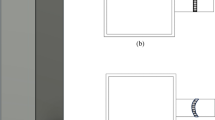Abstract
Karstic collapse pillar (KCP) is a special geological structure caused by the palaeo-karst subsidence in carbonate areas, and it directly affects the safe and efficient production of the coal mines. In this article, in order to improve the recovery rate and reduce relocation of the longwall panel, the water-scarce KCP in 8203 longwall face, Jinzhuang Colliery was directly passed through. Based on the field conditions of KCP and above initial mining problems, a stress changes model including four stress zones in the surrounding rock is established. They are crushing zone, plastic stress-decreasing zone, elastic stress-increasing zone and in situ stress zone from inside out in turn. A variety of measures were taken to ensure that the longwall face safely and efficiently crossed the KCP. These measures contained intensive arched shed instead of bolt-mesh-spurting supporting technique, injection of cement and marithan, respectively, into longwall face in KCP and developmental plastic coalwall at the end of KCP, hard rock blast, reduction of mining height and increase in the working face drainage ability. During the face’s passing through the KCP, working resistance of the support indicated that four-stress-zone model of the surrounding rock with the KCP conformed to field observations.
















Similar content being viewed by others
References
Bai Q, Tu S, Zhang X, Zhang C, Yuan Y (2014) Numerical modeling on brittle failure of coal wall in longwall face—a case study. Arabian J Geosci 7(12):5067–5080
Brown ET, Hoek E (1978) Trends in relationships between measured in situ stresses and depth. International journal of rock mechanics and mining sciences & geomechanics abstracts. Pergamon 15(4):211–215
He K, Wang B, Du R (2005) Karst collapse in north China[M]. Geological Publishing Company, Beijing, pp 152–166
He K, Yu G, Lu Y (2009) Palaeo-karst collapse pillars in northern China and their damage to the geological environments[J]. Environ Geol 58(5):1029–1040
Hosseini N, Oraee K, Shahriar K, Goshtasbi K (2013) Studying the stress redistribution around the longwall mining panel using passive seismic velocity tomography and geostatistical estimation. Arabian J Geosci 6(5):1407–1416
Hsu YC, Forman RG (1975) Elastic–plastic analysis of an infinite sheet having a circular hole under pressure. J Appl Mech 42(2):347–352
Jia G, Hu K (1989) The formation and distribution regularity of collapse pillars in coalfields of North China. Carsol Sin 8(4):261–264
Li L, Tang C, Liang Z, Ma T, Zhang Y (2009) Numerical simulation on water inrush process due to activation of collapse columns in coal seam floor [J]. J Mining Safety Eng 26(2):158–162
Liu Z, Xiong C (2007) Numerical simulation study on water inrush mechanism from collapse column[J]. Chin J Rock Mech Eng 26(2):4013–4018
Ma D, Bai H, Wang Y (2015) Mechanical behavior of a coal seam penetrated by a karst collapse pillar: mining-induced groundwater inrush risk[J]. Nat Hazards 75(3):2137–2151
Ou S, Wang L, Wang P, Wang Z, Huang J, Zhou D (2013) Numerical analysis of seepage flow characteristic of collapse column under the influence of mining[J]. Int J Mining Sci Technol 23(2):237–244
Santarelli FJ, Brown ET, Maury V (1986) Analysis of borehole stresses using pressure-dependent, linear elasticity[C]//International journal of rock mechanics and mining sciences & geomechanics abstracts. Pergamon 23(6):445–449
Song Y, Wang X, Cheng P, Peng C, Xu S (2011) The mechanical criterion and numerical simulation of thick-walled elliptical cylinder collapse column model under water inrush[J]. J China Coal Soc 36(3):452–455
Wang J, Wang S, Xiong C (2009a) The collapse column development characteristics and the evaluation on water bursting risk of Wuyang coal mine[J]. J China Coal Soc 34(7):922–926
Wang X, Zhang M, Wang S (2009b) Elastoplastic analysis of surrounding rocks of subsea tunnel with consideration of seepage and material softening. Rock Soil Mech 30(11):3267–3272
Xie G, Chang J, Yang K (2009) Investigations into stress shell characteristics of surrounding rock in fully mechanized top-coal caving face[J]. Int J Rock Mech Min Sci 46(1):172–181
Xu J, Liang K, Xu X (2008) Mechanics mechanism of forming karst collapse columns and numerical simulation. J Mining Safety Eng 30(1):82–86
Yao B, Mao X, Wei J, Wang D (2014) Study on coupled fluid-solid model for collapse columns considering the effect of particle transport. J China Univ Mining Technol 43(1):30–35
Yin S, Wang S (2003) A numerical simulation analysis of influence of karstic collapse columns on rock mass yield and water inrush from coal floor[J]. J China Coal Soc 28(3):264–269
Yin S, Wang S, Wu Q (2004a) Water inrush patterns and theoretic criteria of karstic collapse columns[J]. Chin J Rock Mech Eng 23(6):964–968
Yin S, Wu Q (2004) Simulation and mechanism analysis of water inrush form karstic collapse columns in coal floor[J]. Chin J Rock Mech Eng 23(15):2551–2556
Yin S, Wu Q, Wang S (2004b) Studies on characters and forming mechanism of karstic collapse columns at mine area of North China[J]. Chin J Rock Mech Eng 23(1):120–123
Yu Z (1990) The characteristic and prediction of collapse of palaeokarst pillars. Coal Geol Explor 2:42–45
Acknowledgments
Financial support for this work was provided by the Fundamental Research Funds for the Central Universities (2015XKZD04), the Priority Academic Program Development of Jiangsu Higher Education Institutions (PAPD).
Author information
Authors and Affiliations
Corresponding author
Rights and permissions
About this article
Cite this article
Zhang, C., Tu, S. Control technology of direct passing karstic collapse pillar in longwall top-coal caving mining. Nat Hazards 84, 17–34 (2016). https://doi.org/10.1007/s11069-016-2402-1
Received:
Accepted:
Published:
Issue Date:
DOI: https://doi.org/10.1007/s11069-016-2402-1




